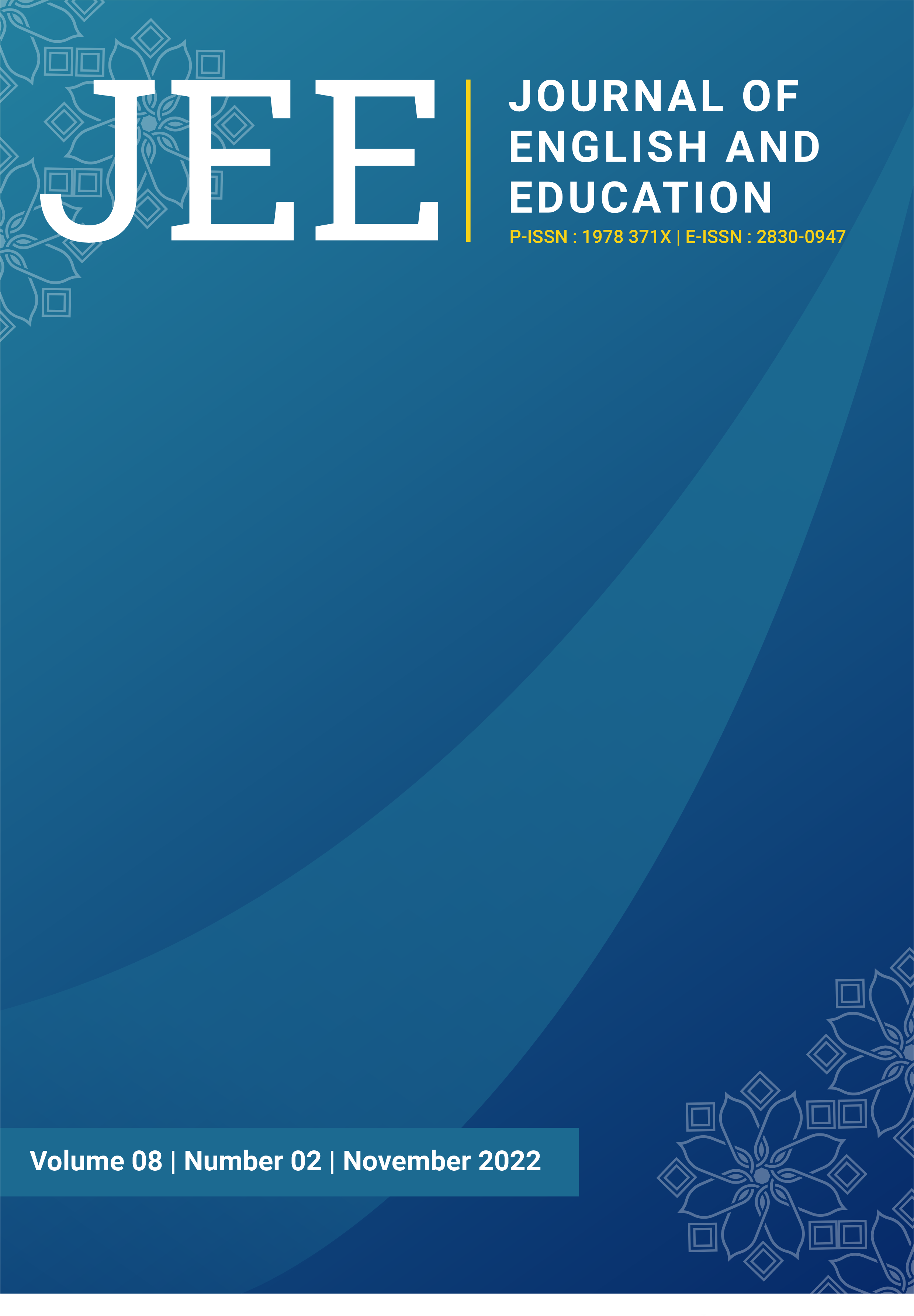Main Article Content
Abstract
The COVID-19 pandemic has forced the educational world to switch from offline classes to online classes. Limited access to the internet has encouraged many people to use WhatsApp to teach instead of academic platforms. Although WhatsApp is not designed for educational purposes, many teachers prefer using it to conduct online discussions, including in English classes. This new model of communication using WhatsApp for English classes has resulted in the interesting phenomenon of code-mixing. This paper aims to investigate the types and functions of code-mixing used in WhatsApp groups of online English classes. This study employed a qualitative method. The sample of this research was conversations between the lecturers and students in WhatsApp group chats of online English classes during the pandemic. The data were collected through observation. The collected data were then analyzed by using textual analysis. This study revealed three types of code-mixing used in online English classes on WhatsApp group chats: insertion, alternation, and congruent lexicalization. Next, this study found five functions of code-mixing in online English classes on WhatsApp group chats: quotation, address specification, interjection, message qualification, personalization, and objectification. Address specification, personalization, and objection were dominantly found because specific sentences frequently refer to people, things, or arguments during discussions on WhatsApp group chats.
Keywords
Article Details
Copyright (c) 2022 Lina Rahmawati, Mar'atus Sholeha, Haira Rizka

This work is licensed under a Creative Commons Attribution-ShareAlike 4.0 International License.
Authors who publish with this journal agree to the following terms:
- Authors retain copyright and grant the journal right of first publication with the work simultaneously licensed under a Creative Commons Attribution-ShareAlike 4.0 International License that allows others to share the work with an acknowledgment of the work's authorship and initial publication in this journal.
- Authors are able to enter into separate, additional contractual arrangements for the non-exclusive distribution of the journal's published version of the work (e.g., post it to an institutional repository or publish it in a book), with an acknowledgment of its initial publication in this journal.
- Authors are permitted and encouraged to post their work online (e.g., in institutional repositories or on their website) prior to and during the submission process, as it can lead to productive exchanges, as well as earlier and greater citation of published work (See The Effect of Open Access).
References
- Agung, A., Dian, A., Ayu, I. D., & Maharani, D. (2022). Code Mixing Applied in Interaction of Students and Lecturers in WhatsApp Media.
- Ani, S., Setiawati, P., & Farahsani, Y. (2021). Code-Switching and Code-Mixing in WhatsApp Group Chats by FEB UMY Lecturers. Advances in Social Science, Education and Humanities Research, 518, 362–369.
- Haryati, & Prayuanal, R. (2020). An Analysis of Code-Mixing Usage in WhatsApp Groups Conversation among Lecturers of Universitas Pamulang An Analysis of Code-Mixing Usage in WhatsApp Groups Conversation among Lecturers of Universitas Pamulang, 7(2), 236–250. https://doi.org/10.30605/25409190.180
- Muttaqien, S. R. I., Sulatra, I. K., & Jendra, I. M. I. (2022). Identify the types & reason of code mixing found in whatsapp group cargo department staff at ngurah rai airport. Journal of Language and Applied Linguistics, 03(01), 85–94.
- Noorzaina, & Hayati, N. (2017). Code-Mixing And Code-Switching Practice Among Uitm Undergraduates Students In Face-To-Face And Whatsapp Group Application. AIJLLS, 1(4).
- Putri, K. R. D., Utami, N. M. V., & Ariyaningsih, N. N. D. (2022). Code Switching and Code Mixing Found In The Swallow Stuff’s Utterence. Journal of Language and Culter, 13(1), 34–41.
- Rabiah, S. (2012). Language as a tool for communication and cultural reality discloser, 1–11.
- Try, H., Simatupang, A., & Dirgeyasa, I. W. Y. (2019). Code-Mixing In Whatsapp (WA) Chat Group IBAD Lovers. Journal of English Language Teaching, 8(4), 1–14.
References
Agung, A., Dian, A., Ayu, I. D., & Maharani, D. (2022). Code Mixing Applied in Interaction of Students and Lecturers in WhatsApp Media.
Ani, S., Setiawati, P., & Farahsani, Y. (2021). Code-Switching and Code-Mixing in WhatsApp Group Chats by FEB UMY Lecturers. Advances in Social Science, Education and Humanities Research, 518, 362–369.
Haryati, & Prayuanal, R. (2020). An Analysis of Code-Mixing Usage in WhatsApp Groups Conversation among Lecturers of Universitas Pamulang An Analysis of Code-Mixing Usage in WhatsApp Groups Conversation among Lecturers of Universitas Pamulang, 7(2), 236–250. https://doi.org/10.30605/25409190.180
Muttaqien, S. R. I., Sulatra, I. K., & Jendra, I. M. I. (2022). Identify the types & reason of code mixing found in whatsapp group cargo department staff at ngurah rai airport. Journal of Language and Applied Linguistics, 03(01), 85–94.
Noorzaina, & Hayati, N. (2017). Code-Mixing And Code-Switching Practice Among Uitm Undergraduates Students In Face-To-Face And Whatsapp Group Application. AIJLLS, 1(4).
Putri, K. R. D., Utami, N. M. V., & Ariyaningsih, N. N. D. (2022). Code Switching and Code Mixing Found In The Swallow Stuff’s Utterence. Journal of Language and Culter, 13(1), 34–41.
Rabiah, S. (2012). Language as a tool for communication and cultural reality discloser, 1–11.
Try, H., Simatupang, A., & Dirgeyasa, I. W. Y. (2019). Code-Mixing In Whatsapp (WA) Chat Group IBAD Lovers. Journal of English Language Teaching, 8(4), 1–14.

